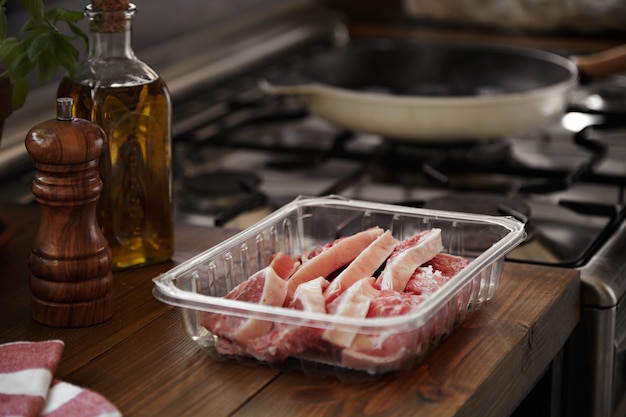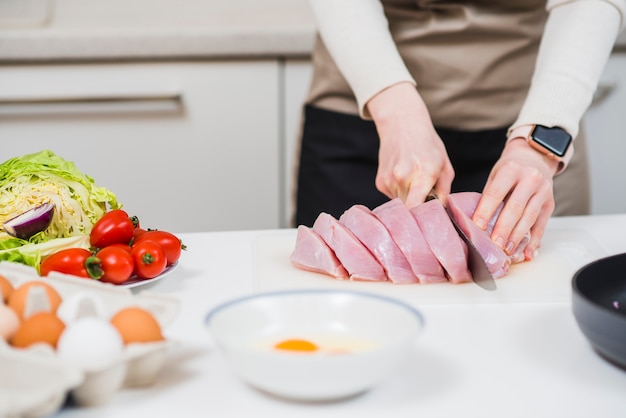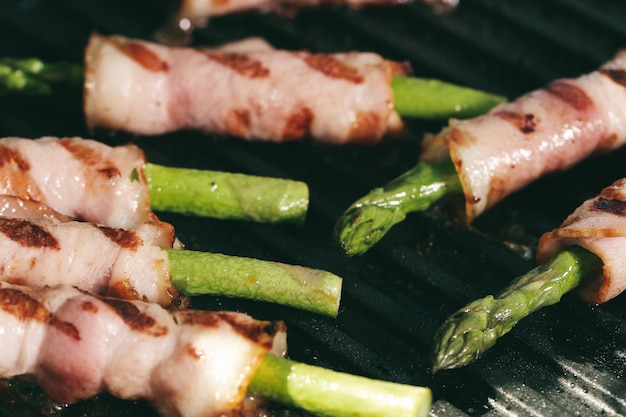Oh, bacon. The smell alone is enough to make your mouth water. That perfect, golden-brown, crispy goodness... it's the stuff of breakfast dreams. But let's be honest, achieving that elusive texture can be a bit of a culinary gamble. You've probably experienced those soggy, limp bacon disasters, right? I know I have. Countless burnt offerings and countless soggy disappointments - it's enough to make you want to give up on bacon altogether.
But fear not, my fellow bacon lovers! After years of trial and error, countless burnt offerings, and countless soggy disappointments, I've finally cracked the code. And it all comes down to the temperature, my friends. It's not just about the heat, but the precise control of that heat. So, let's embark on a journey together to discover the secrets of achieving that gloriously crispy bacon every single time.
(Part 1) The Great Bacon Temperature Debate

First things first, we need to address the elephant in the room: the temperature. There are a million different opinions out there, from the "high and fast" brigade to the "low and slow" crew. It can be a real head-scratcher, trust me. I've spent hours scouring the internet, reading countless articles, and even engaging in heated debates with fellow bacon aficionados (yes, I'm serious) - all in the name of finding the perfect bacon temperature.
The High Heat Method: A Quick and Crispy Challenge
This approach is all about blasting the bacon with high heat, usually in a hot pan or under the broiler. The idea is to sear the bacon quickly, creating a crispy exterior and leaving the inside juicy. It's definitely a tempting idea, and it can deliver a satisfying crunch. I've tried it myself, and it can be delicious... if you get it right. But it's also a bit of a risky move. You're constantly hovering over the stove, watching the bacon like a hawk, making sure it doesn't burn to a crisp. One moment of distraction and you could end up with a charred mess.
The Low and Slow Method: Patience is a Virtue (For Bacon)
The low and slow method takes a more patient approach, cooking the bacon at a lower temperature for a longer period. It promises even cooking, rendering out more fat, and achieving a consistent level of crispiness. While this might sound like the more forgiving option, you have to be prepared to commit to a longer cooking time. I've tried this method too, and it definitely produces a delicious bacon, but it can feel a bit like a waiting game. For someone as impatient as me, it's a real test of willpower!
(Part 2) The Science Behind Perfect Bacon: Unveiling the Magic

Now, let's delve into the science behind it all. We're not just talking about temperature here, but also about the physics and chemistry of bacon. Understanding these principles will give you a better grasp of the magic that happens when you cook your bacon.
Fat Rendering and Maillard Reactions: The Keys to Bacon Bliss
When you cook bacon, the fat starts to render out, leaving a crispier and more flavorful product. Think of it like this: the fat melts away, leaving behind the delicious, crispy bacon bits we all love. But it's not just about the fat, it's also about those lovely Maillard reactions. These are the chemical reactions between sugars and amino acids that create those gorgeous brown tones and complex flavors. They're responsible for that irresistible, savory aroma that fills the kitchen as the bacon cooks. These reactions thrive in the temperature range of 285-320°F (140-160°C). The higher the temperature, the faster these reactions occur, giving you that intense, deep flavor.
The Importance of Temperature Control: Finding the Sweet Spot
Now, let's get back to temperature. The ideal temperature range for cooking bacon is somewhere between 350°F (175°C) and 400°F (200°C). This temperature range strikes a balance between achieving that desirable crispiness while avoiding burning. It's like finding the sweet spot where the fat renders nicely, and the Maillard reactions kick in beautifully, without scorching the bacon.
(Part 3) My bacon cooking Arsenal: The Tools of the Trade

Over the years, I've experimented with various methods and equipment to achieve that perfect bacon. Some have proven to be absolute game-changers, while others have been relegated to the back of the cupboard. Let me share some of my favorite tools and techniques with you.
My Top Bacon-Cooking Tools: Essential for Success
Here are the essential tools that I swear by for achieving bacon perfection:
- cast iron skillet: This sturdy workhorse is a bacon-cooking legend. Its even heat distribution ensures consistent cooking and the ability to retain heat makes it perfect for achieving that crispy texture. It's also a great option for those who like to cook their bacon on the stovetop.
- bacon press: A must-have for any bacon lover! It helps to flatten the bacon strips, ensuring even cooking and faster rendering of the fat. It also prevents the bacon from curling up, making it easier to handle and giving you those nice, flat pieces for sandwiches or salads.
- Spatula: A good spatula is essential for flipping the bacon and removing it from the pan. Choose one with a thin blade for easy maneuvering. You want a spatula that won't tear or break the bacon as you flip it.
- Thermometer: A trusty thermometer is crucial for monitoring the temperature of your cooking surface. It takes the guesswork out of achieving that perfect bacon temperature. It's like having a little bacon whisperer telling you exactly when the temperature is right.
My Secret Weapon: The Oven - Bacon's Hidden Paradise
Believe it or not, my secret weapon for perfect bacon is my oven. I've found that the oven provides a more consistent and controlled environment for cooking bacon. It's like a little bacon haven where everything can cook evenly without burning. You don't have to stand there and watch it, and it gives you the freedom to do other things while the bacon cooks.
(Part 4) Mastering the Oven Bacon Method: Simplicity and Deliciousness
I know what you're thinking: "Isn't oven-baked bacon a bit boring?" Trust me, it's anything but! It's surprisingly quick, incredibly easy, and delivers perfectly crispy bacon every time. Here's how I do it:
Step 1: Preheat the Oven: Setting the Stage for Crispy Perfection
Preheat your oven to 400°F (200°C). This ensures that the bacon starts cooking immediately upon hitting the oven rack. It's like giving the bacon a warm welcome and letting it know the party's about to start.
Step 2: Line a Baking Sheet with Foil: Cleanliness is Key
Line a baking sheet with aluminum foil. This will catch any rendered fat and make cleanup a breeze. You can also use parchment paper for a grease-free option. No one wants to spend hours scrubbing bacon grease off their baking sheet after the deliciousness is over.
Step 3: Arrange the Bacon: Giving it Room to Breathe
Place the bacon strips in a single layer on the prepared baking sheet. Avoid overcrowding the bacon, as it will steam and prevent it from crisping up properly. Think of it as giving each piece of bacon its own personal space to shine.
Step 4: Bake to Perfection: The Magic Happens Here
Bake the bacon for 15-20 minutes, or until it reaches your desired level of crispiness. Flip the bacon halfway through for even cooking. This ensures that both sides get that perfect golden-brown color and crispy texture.
Step 5: Drain Excess Fat: Achieving That Perfect Crunch
Once the bacon is cooked to perfection, remove it from the oven and place it on a paper towel-lined plate to drain any excess fat. This will prevent the bacon from becoming soggy and ensure that it stays crispy. You want that perfect crunch, not a limp, greasy mess.
(Part 5) My Bacon Temperature Guide: A Personalized Approach
Now, let's talk numbers. I've created a bacon temperature guide to help you achieve the perfect level of crispiness for your taste buds. It's not about finding one perfect temperature for all bacon, but about adjusting the temperature based on your preferences and the thickness of the bacon.
Bacon Temperature Guide: The Art of Finding Your Sweet Spot
| Bacon Type | Temperature (°F) | Cooking Time (Minutes) | Result |
|---|---|---|---|
| thick-cut bacon | 400 | 20-25 | Crispy and chewy, with a slight chewiness in the center. This is perfect for those who like a bit of a bite and a satisfying chew. |
| Regular-Cut Bacon | 400 | 15-20 | Crisp and satisfying, with a slight chewiness. This is the classic bacon experience – a balance of crunch and chew. |
| Thin-Cut Bacon | 375 | 10-15 | Crisp and crunchy, perfect for salads or sandwiches. This is for those who want that ultimate crunch and a delicate flavor. |
(Part 6) Bacon cooking tips and Tricks: Elevating Your Game
Okay, now that we've covered the basics, let's move on to some helpful tips and tricks that will elevate your bacon game to the next level. These little secrets can make a big difference in achieving that perfectly crispy, flavorful bacon.
Tips for Crispy Bacon: The Secrets to Ultimate Crunch
Here are some helpful tips to ensure your bacon is perfectly crispy:
- Don't Overcrowd the Pan: Give the bacon strips some breathing room. Overcrowding will lead to steaming and prevent the bacon from achieving that desirable crispiness. Think of it as a spa day for your bacon – it needs space to relax and crisp up properly.
- Flip the Bacon: For even cooking, flip the bacon halfway through. This ensures that both sides achieve that perfect golden-brown hue. It's like giving your bacon a little massage to ensure it cooks evenly.
- Use a Bacon Press: A bacon press helps to flatten the strips and distribute the heat evenly. This allows the fat to render quickly, resulting in crispy bacon. It's like giving your bacon a little hug to ensure it cooks evenly and gets that perfect crispy texture.
- Avoid High Heat: While high heat might seem appealing, it can lead to burning. Stick to the recommended temperature range for optimal results. You want crispy, not charred.
- Drain the Fat: Once the bacon is cooked, drain it on paper towels to remove excess fat. This will prevent the bacon from becoming soggy and ensure that it stays crispy. You want that dry, satisfying crunch, not a greasy mess.
Tricks for Flavorful Bacon: Adding a Touch of Magic
Looking for ways to add more flavor to your bacon? Here are a few tricks up my sleeve:
- Spice It Up: Experiment with different seasonings. Add a pinch of smoked paprika, cayenne pepper, or garlic powder for a little extra kick. You can also try herbs like rosemary or thyme for a more earthy flavor. It's like adding a little personality to your bacon.
- Sweet and Savory: For a sweet and savory twist, try drizzling maple syrup or honey over the bacon while it cooks. This creates a delicious caramelization that will make your bacon taste heavenly. It's the perfect combination of salty and sweet, and it adds a layer of richness to the bacon.
- Citrus Burst: A squeeze of lemon or orange juice can add a refreshing citrus note to your bacon. Just add a few drops to the pan before cooking. It's a surprisingly delicious combination that brightens up the flavor of the bacon.
- Bacon and Beer: Yes, you heard that right! Pour a little beer into the pan while cooking the bacon for a unique and flavorful twist. Use a beer with a hoppy or malty flavor for a delicious combination. It's a fun and unexpected way to add a different dimension to your bacon.
(Part 7) Bacon Beyond the Breakfast Plate: The Culinary Superstar
Now, let's move beyond the breakfast plate and explore the endless possibilities of bacon! It's not just a breakfast staple, it's a culinary superstar that can elevate any meal. From appetizers to desserts, bacon can add a touch of magic to your dishes.
Bacon Appetizers: The Perfect Party Starter
Bacon-wrapped dates, bacon-wrapped shrimp, bacon-wrapped jalape??o poppers – the possibilities are endless! Bacon adds a salty, smoky, and satisfying crunch to any appetizer. It's a delicious way to start a party or a meal.
bacon salads: Adding Crunch and Flavor to Greens
Forget about boring salads! Crumble some crispy bacon over your salad for a burst of flavor and texture. It's a great way to add protein and a savory element to your greens. It's the perfect way to add a little excitement to your salad.
Bacon Burgers and Sandwiches: A Classic Combination
Need I say more? Crispy bacon adds the ultimate touch to any burger or sandwich. It's a perfect pairing with any type of cheese, from cheddar to Swiss. It's like the ultimate comfort food.
Bacon Desserts: The Unexpectedly Delicious Pairing
Wait, what? Yes, bacon can even be delicious in desserts! Think bacon chocolate chip cookies, bacon-caramel cheesecake, or even a bacon-infused ice cream. It's a surprisingly sweet and savory combination. It's a fun and unexpected twist on classic desserts.
(Part 8) FAQs: Addressing Common Bacon Dilemmas
Finally, let's address some of the most common questions about cooking bacon:
1. What if my bacon is too thick?
If your bacon is thick-cut, you may need to cook it for a little longer. Consider lowering the oven temperature slightly to avoid burning. Remember, patience is key for achieving that perfect crispy texture! Don't rush the process, let it cook slowly and evenly.
2. What if my bacon is too thin?
Thin-cut bacon will cook much faster. Be sure to watch it closely and remove it from the oven as soon as it reaches your desired level of crispiness. Thin bacon can burn quickly, so keep a close eye on it.
3. What if I don’t have a thermometer?
While a thermometer is highly recommended, you can use visual cues to determine if the bacon is cooked. The bacon should be golden brown and slightly curled up. If it's still soft and pale, it needs more time. Trust your instincts, and don't be afraid to experiment.
4. Can I cook bacon in the microwave?
Yes, you can cook bacon in the microwave, but it won't be as crispy as oven-baked or pan-fried bacon. It's also important to use microwave-safe bacon and follow the instructions carefully. It's a quick and easy option if you're in a hurry, but it won't give you that same satisfying crunch.
5. How do I store leftover bacon?
Store leftover bacon in an airtight container in the refrigerator for up to 5 days. You can also freeze leftover bacon for up to 3 months. Remember, once it's frozen, it's best to thaw it in the refrigerator overnight and cook it from frozen. This way, you can enjoy your bacon goodness for weeks or even months to come.
Now, go forth, my fellow bacon enthusiasts! Armed with this knowledge, you’re ready to conquer the world of bacon. From achieving that perfect crisp to exploring new and exciting bacon creations, the possibilities are endless. Happy bacon-cooking!
Everyone is watching

Corn on the Cob: The Ultimate Guide to Perfectly Cooked Ears
Healthy MealsAh, corn on the cob. Just the name evokes images of sunny days, barbecues, and that sweet, juicy flavour that ...

Scallops: The Ultimate Guide to Perfect Cooking
Healthy MealsAh, scallops. Those delicate, sweet, and utterly delicious morsels of the sea. They hold a special place in my...

Spaghetti Squash: The Ultimate Guide to Cooking and Serving
Healthy MealsRemember that time you saw spaghetti squash at the supermarket, looking all bumpy and strange, and thought, "W...

Salmon Cooking Times: Perfect Guide for Every Recipe
Healthy MealsLet me tell you, cooking salmon is an art form. It's all about getting that perfect balance: juicy and tender,...

Ham Cooking Time: How Long to Bake, Smoke, or Boil a Delicious Ham
Healthy MealsAh, ham. It's a classic, isn't it? A real crowd-pleaser, especially around holidays. And when done right, it'...
